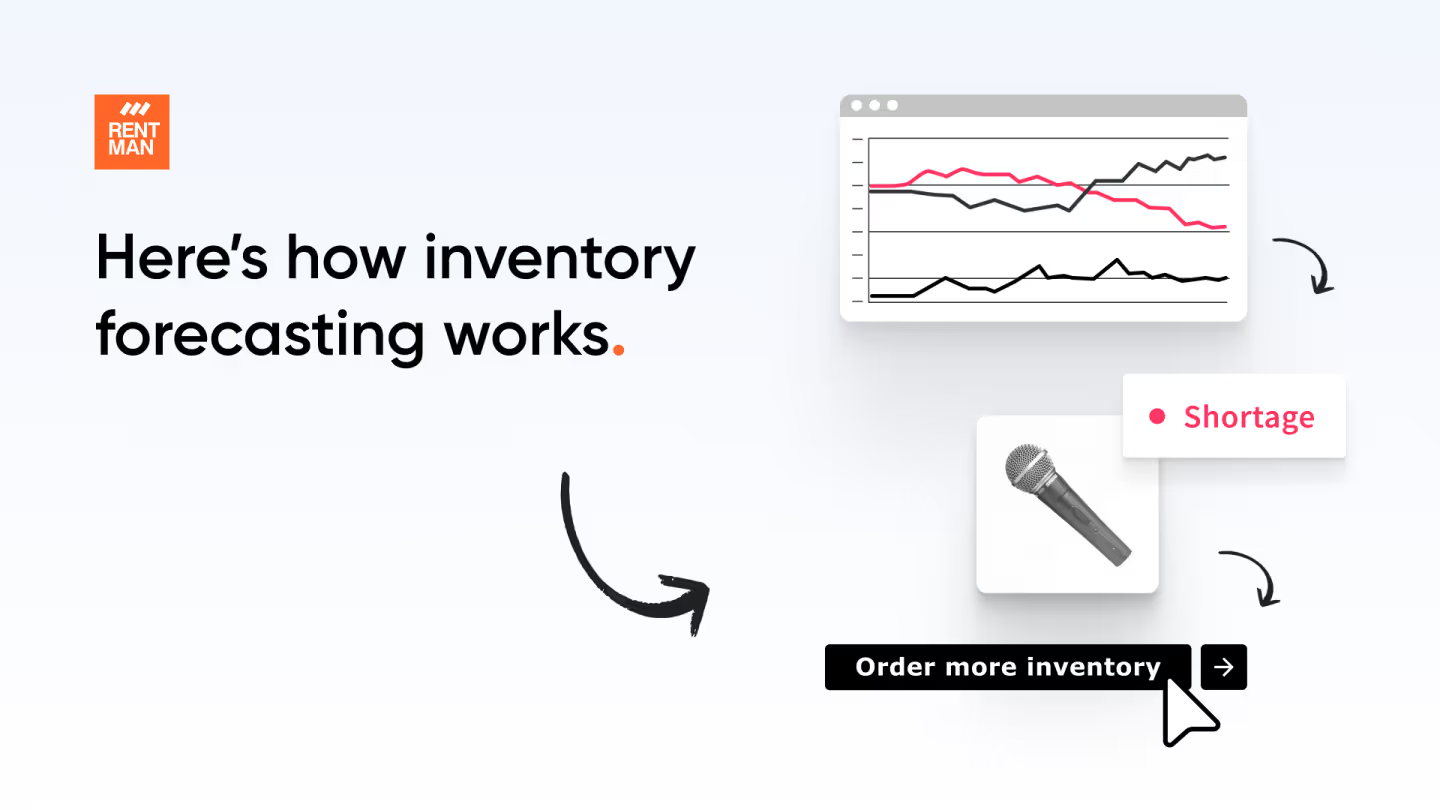Inventory forecasting: 7 steps to predicting your inventory

It’s important to know how much inventory to always have on hand, how much to order, and when. Because if you have too much stock, you’ve wasted money and shelf space. If you have too little, you won’t be able to meet client demand. Leaving them feeling frustrated and sending them to your competitors for their next booking.
To avoid that, we’re going to give you some ideas on how to forecast your inventory demand. Here are the details of what we’ll go over:
1. What is inventory forecasting?
2. Benefits of inventory forecasting
3. What are the types of inventory forecasting?
4. How to forecast your inventory
5. Inventory forecasting software
What is inventory forecasting?
Inventory forecasting, also known as demand planning or demand forecasting, is predicting how much inventory you need to order ahead of time.
However, this isn’t based on gut feeling. Instead, it’s based on past data, trends, and known upcoming events. This data dictates your needed inventory levels for a future period.
For example, before the wedding season or summer festivals start, use demand forecasting to analyze your equipment turnover over the last few years. Use that information to predict how much of each item you will need to have on hand before this year’s season.
Benefits of inventory forecasting
Apart from ensuring you have enough supplies to cater to your customers, good inventory forecasting can:
- Provide an overview of upcoming costs: Inventory forecasting enables you to plan upcoming asset costs more accurately.
- Save your company money: Avoid having too much cash tied up in unused or unsold inventory.
- Prevent stockouts and keep your supply chain running smoothly: You’ll always have needed supplies on hand, meaning no more last-minute rush to order or buy things 24 hours before an event.
- Increase customer satisfaction: Consistently meet customer demand and ensure a steady supply of products to keep your clients happy. Doing so contributes to a positive brand reputation.
- Optimize your storage: Don’t waste unnecessary shelf space on items you don’t use a lot. Instead, ensure you only have the items you need on hand.
What are the types of inventory forecasting?
There are several approaches you can take to forecast how much inventory you should have on hand. Here are the most common methods:
- Predict future sales based on historical sales data and a market analysis to project future customer demand.
- If historical sales data isn’t relevant for your company, predict demand for a product based on current market demand.
Ways to visualize the forecast:
- Graphical: If you’re more of a visual person, graph historical data to observe changes and severe fluctuations.
- Quantitative: This method of inventory forecasting uses only numbers to present the future demand.
How to forecast your inventory in 7 steps
Inventory forecasting is a core part of your company’s operations. Why? Because it enables you to strike a balance between having too much cash tied up in inventory and not having enough stock to meet demand.
Here's a step-by-step overview of how to forecast your inventory manually.
1. Decide on a forecast period
Start by picking how far out you’d like to forecast. Most companies opt for either 30, 60, 90 days, or one year. However, keep in mind that the further out your forecast, the less accurate it is given market changes.
2. Review your base demand
Look back at past sales data for the same period you’d like to forecast. How many units of each item did you sell? Use that number as a starting point.
For example: if you sold 500 packs of batteries in the last 90 days, that’s your starting point.
3. Predict any upcoming trends and variables
Next, identify any trends or variables that will impact your sales. From seasonal promotions to peak periods (such as wedding season), keep these factors in mind to create a more accurate forecast.
Lastly, identify past occurrences that are unlikely to happen again. This ensures you don’t needlessly order too much stock.
4. Calculate your average lead time demand
Lead time demand is the amount of inventory that you need to have on hand after ordering to ensure that you have enough stock until the new order arrives.
To calculate this, multiply the quantity of an item that you sell in a day (on average) by how long it takes for your supplier to deliver an order. Use past sales numbers and average delivery times to get a number.
For example: if you typically sell 20 packs of batteries in a day and it takes 2 days for your supplier to deliver, you’d multiply 20 x 2. And your average lead time demand equals 40.
5. Determine your safety stock
Safety stock serves as a buffer against unexpected fluctuations in demand or delays in the supply chain. It is one of the inventory control techniques that helps you plan for unexpected situations by ensuring you have a cushion of extra products. Ensuring you can keep providing to customers if an order doesn’t come in as planned.
To find your safety stock level, first, figure out the most units you've sold in a single day for a product. Then multiply that number by the longest time it has taken for your supplier to deliver.
For instance: if you once sold 100 packs of batteries in a day and it took your supplier at most 5 days to deliver, then multiply 100 x 5 = 500.
To determine your safety stock, subtract your average lead time from the number above.
Example: 500 - 40 = 460. Meaning, your company should always have 460 packs of batteries on hand as safety stock.
6. Decide on a reorder point
Your reorder point is the inventory level at which you place a new order to avoid stockouts. It's basically a red alert to submit an order ASAP. If you track your inventory, this should be easy to keep an eye on.
The formula for this is simple. Add together your safety stock number, your average daily unit sale, and your average delivery time.
For example: 460 + 20 + 2 = 482.
To avoid risking running out of an item too soon, replenish your stock when you reach this point. In this example, you’d reorder when you’re down to 482 packs of batteries.
If you use Rentman, you can see this via our sales shortage module. No need to calculate when you should reorder. Rentman gives an overview of all your sales items. Use this overview to see exactly when each item will run out of stock and set a repeat reorder point.
7. Calculate the necessary reorder quantity
When reordering a popular product, you want to be sure to not order too much and waste money, but also too little.
However, this step is easy. Your reorder quantity is the same as your average lead time demand. So, whenever you get down to 482 packs of batteries, simply order another 20 from your supplier.

Inventory forecasting software
However, it doesn’t have to be done manually. These 7 steps enable you to calculate it by hand. But predictive analytics, one of the top trends of stock management currently, can help you to create a more accurate forecast.
Alternatively, invest in inventory forecasting software which takes care of this process for you after an initial set-up phase.
When choosing inventory forecasting software, think about these factors:
- Forecasting methods.
- Reporting capabilities.
- Integration options.
- Ease of use.
- Implementation and support.
Lastly, the right solution should be able to grow with your business. Therefore, consider scalability options when picking an inventory forecasting software.
Get a grip on your inventory
Inventory forecasting is the smart way to manage your stock.
However, it doesn’t have to be done manually. These 7 steps enable you to calculate it by hand. But predictive analytics, one of the top trends of stock management currently, can help you to create a more accurate forecast.
Alternatively, invest in demand forecasting software which takes care of this process for you after an initial set-up phase.
FAQ
Frequently asked questions
No items found.
Previous blog posts



